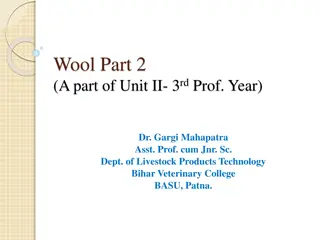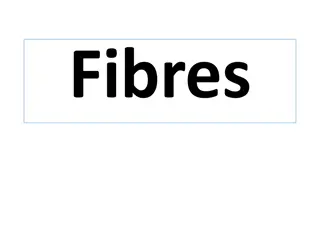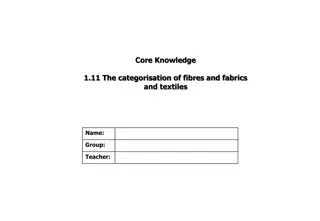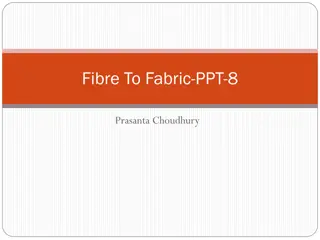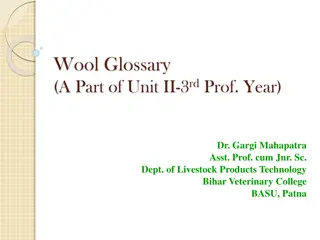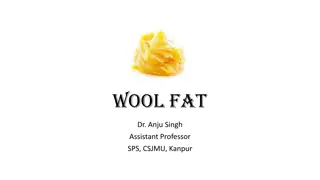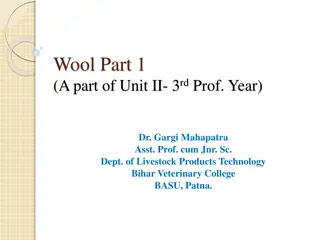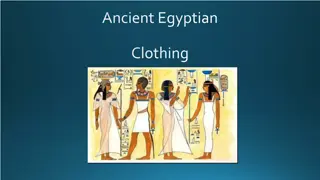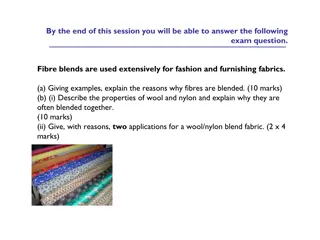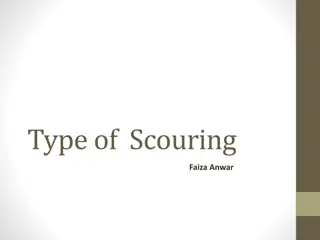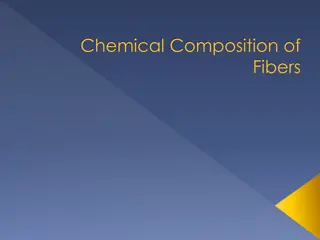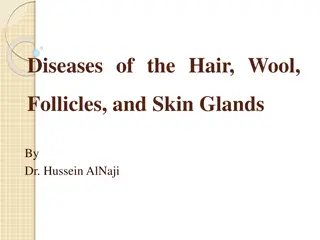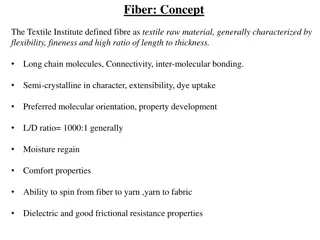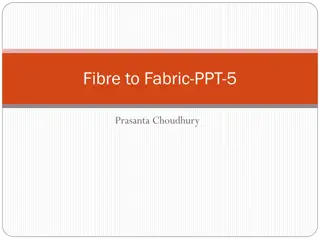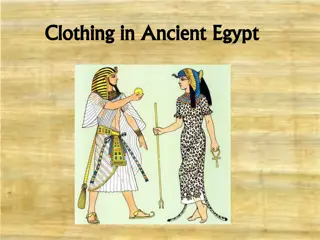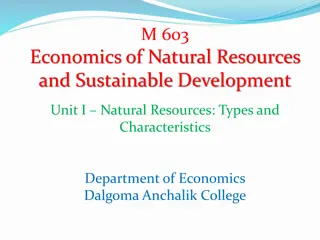Natural Fibres: Wool and Linen Applications and Characteristics
Wool, sourced from sheep, is known for its crimped appearance, elasticity, and hygroscopic nature. It finds applications in clothing, blankets, and upholstery. Linen, made from flax, boasts exceptional coolness and freshness, with applications in apparel, home furnishings, and industrial products. Both fibres have unique characteristics and versatile uses.
Download Presentation

Please find below an Image/Link to download the presentation.
The content on the website is provided AS IS for your information and personal use only. It may not be sold, licensed, or shared on other websites without obtaining consent from the author. Download presentation by click this link. If you encounter any issues during the download, it is possible that the publisher has removed the file from their server.
E N D
Presentation Transcript
Presented by Presented by Dr. Dr. Ila Ila Jogi Jogi Head, Department of Home Science Head, Department of Home Science Mahila Mahila Mhavidyalaya Mhavidyalaya, , Karad Karad
Wool Wool fibre grows from the skin of sheep and is a relatively coarse and crimped fibre with scales on its surface. It is composed of protein. The fibre appearance varies depending on the breed of the sheep. Finer, softer and warmer fibres tend to be with more and smoother scales. Thicker, less warm fibres have fewer and rougher scales. Normally, the better wool fibres with finer scales are duller in appearance than the poorer quality fibres which have fewer scales. Characteristics Crimped in appearance Elastic Hygroscopic, readily absorbs moisture Ignites at a higher temperature than cotton Lower rate of flame spread, heat release and combustion heat Resistant to static electricity
Applications Clothing jackets, suits, trousers, sweaters, hats etc. Blankets, carpets, felt and upholstery Horse rugs, saddle clothes
Linen, one of the most expensive natural fibres, is made from the flax plant. It is labour- intensive to produce, hence produced in small quantities. However linen fabric is valued for its exceptional coolness and freshness in hot weather. It is composed of 70% cellulose and 30% pectin, ash, woody tissue and moisture. Characteristics Strongest vegetable fibre Poor elasticity, hence wrinkles easily Relatively smooth, becomes softer when washed Highly absorbent Good conductor of heat and feels cool Lustrous More brittle, constant creasing in the sharp folds, tends to break Damaged by mildew, perspiration and bleach Resistant to moths and carpet beetles Applications Apparel - suits, dresses, skirts, shirts etc. Home and commercial furnishing items table cloths, dish towels, bed sheets, wallpaper / wall coverings, window treatments etc. Industrial products - luggage, canvas etc. Used as blend with cotton
Wool fibre grows from the skin of sheep and is a relatively coarse and crimped fibre with scales on its surface. It is composed of protein. The fibre appearance varies depending on the breed of the sheep. Finer, softer and warmer fibres tend to be with more and smoother scales. Thicker, less warm fibres have fewer and rougher scales. Normally, the better wool fibres with finer scales are duller in appearance than the poorer quality fibres which have fewer scales. Characteristics Crimped in appearance Elastic Hygroscopic, readily absorbs moisture Ignites at a higher temperature than cotton Lower rate of flame spread, heat release and combustion heat Resistant to static electricity Applications Clothing jackets, suits, trousers, sweaters, hats etc. Blankets, carpets, felt and upholstery Horse rugs, saddle cloths
Silk Silk is a fine, continuous strand unwound from the cocoon of a moth caterpillar known as the silkworm. It is composed of protein. It is very shiny due to the triangular prism-like structure of the silk fibre, which allows silk cloth to refract incoming light at different angles. Applications Shirts, ties, blouses, formal dresses, high- fashion clothes lingerie, pyjamas, robes, dress suits and sun dresses Many furnishing applications Upholstery, wall coverings, and wall hangings Characteristics Lustrous, smooth and soft texture and not slippery Lightweight, strong, but can lose up to 20% of its strength when wet Elasticity is moderate to poor. If elongated, it remains stretched Can be weakened if exposed to too much sunlight May be affected by insects, especially if left dirty Can regain up to 11% of its moisture
Jute Jute is taken from a tall plant of the same name and it is easy to cultivate and harvest. It is the cheapest fibre and is used in great quantities. Applications Binding threads for carpets, coarse and cheap fabrics, heavy bagging etc. Characteristics It is not durable as it deteriorates rapidly when exposed to moisture Less strength Cannot be bleached to make it pure white due to lack of strength
Kapok It is a white hair-like fibre obtained from the seed capsules of plants and trees called Ceiba Pentandra grown in Java and Sumatra (Indonesia), Mexico, Central America and the Caribbean, Northern South America and tropical West Africa. It is called silk cotton due to its high lustre which is equal to that of silk. Applications Mattresses, cushions, upholstered furniture Characteristics: Smooth texture Very lustrous Weak Short fibre length Resistant to moisture, dries quickly when wet
Ramie A woody fibre resembling flax and it is also known as rhea and China grass. It is taken from a tall flowering plant. Characteristics Stiff More brittle Lustrous Applications Canvas, upholstery, clothing, etc.
Man-made (Regenerated) Cellulosic They are derived either from the cellulose of the cell walls of short cotton fibres that are called linters or, more frequently from pine wood. There are three types of man made cellulosic fibres: Rayon, acetate and tri-acetate
Rayon Rayon is made from naturally occurring polymers that simulate natural cellulosic fibres. It is neither a truly synthetic fibre nor a truly natural fibre. There are two varieties of Rayon; viscose and high wet modulus (HWM). These in turn are produced in a number of types to provide certain specific properties. Applications Apparel - blouses, dresses, jackets, lingerie, linings, suits, neck ties etc. Furnishing items - bedspreads, bed sheets, blankets, window treatments, upholstery etc. Industrial uses e.g. medical surgery products, non-woven products, tyre cord etc. Other uses - feminine hygiene products, diapers, towels etc. Characteristics Soft, smooth and comfortable Naturally high in lustre Highly absorbent Durability and shape retention is low, especially when wet Low elastic recovery Normally weak, but HWM rayon is much stronger, durable and has good appearance retention.
Acetate Acetate consists of a cellulose compound identified as acetylated cellulose a cellulose salt. Hence it possesses different qualities compared to rayon. Acetate is thermoplastic and can be formed into any shape by application of pressure combined with heat. Acetate fibres have good shape retention. Characteristics Thermoplastic Good drapability Soft, smooth and resilient Wicks and dries quickly Lustrous appearance Weak, rapidly loses strength when wet, must be dry-cleaned Poor abrasion resistance Applications Primarily in apparel - blouses, dresses, jackets, lingerie, linings, suits, neck ties, etc. Used in fabrics such as satins, brocades, taffetas, etc.
Tri-acetate Tri-acetate consists of acetylated cellulose that retains acetic groupings, when it is being produced as triacetate cellulose. It is a thermoplastic fibre and is more resilient than other cellulosic fibres Applications Primarily apparel Used in clothing where crease / pleat retention is important e.g. skirts and dresses Can be used with polyester to create shiny apparel Characteristics Thermoplastic Resilient Shape retentive and wrinkle resistant Shrink resistant Easily washable, even at higher temperatures Maintains creases and pleats well
Man-made Non-cellulosic Polymer Fibres This group of fibres is distinguished by being synthesised or created from various elements into larger molecules that are called linear polymers. The molecules of each particular compound are arranged in parallel lines in the fibre. This arrangement of molecules is called molecular orientation. The properties of such fibres are dependent on their chemical composition and kinds of molecular orientation. Nylon
In nylon, the fibre forming substance is a long- chain synthetic polyamide in which less than 85% of the amide linkages are attached directly to two aromatic rings. The elements carbon, oxygen, nitrogen and hydrogen are combined by chemical processes into compounds which react to form long-chain molecules, chemically known as polyamides and are then formed into fibres. There are several forms of nylon. Each depends upon the chemical synthesis. They are: Nylon 4; 6; 6.6; 6.10; 6.12; 8; 10; and 11. NYLON Characteristics Highly resilient High elongation and elasticity Very strong and durable Excellent abrasion resistance Thermoplastic Has the ability to be very lustrous, semi- lustrous or dull Resistant to insects, fungi, mildew and rot Applications Apparel pantyhose, stockings, leggings, etc. Home furnishing Industrial applications - parachutes, tyre cords, ropes, airbags, hoses, etc.


